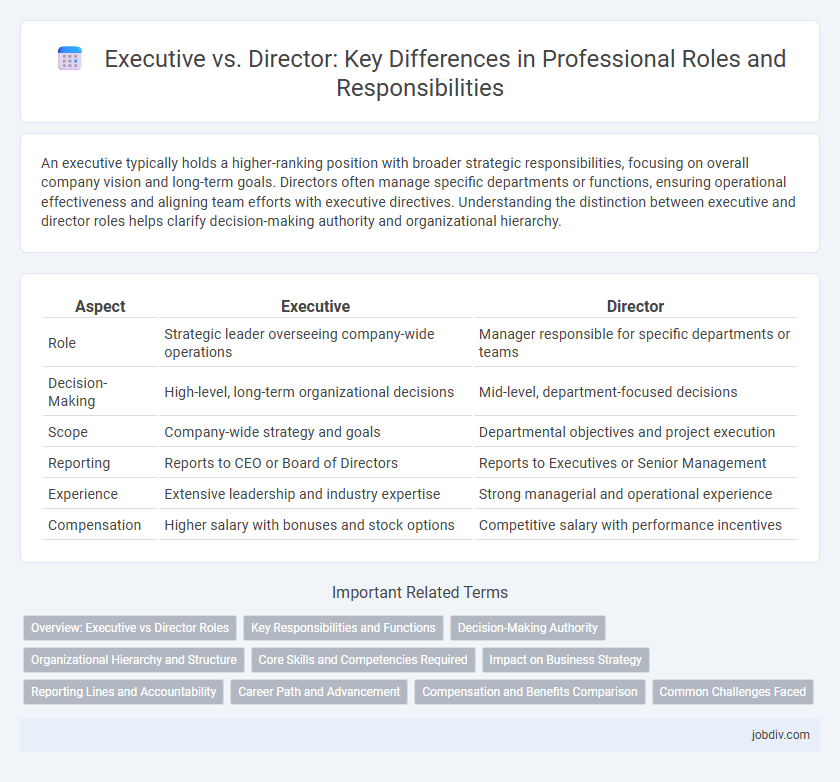An executive typically holds a higher-ranking position with broader strategic responsibilities, focusing on overall company vision and long-term goals. Directors often manage specific departments or functions, ensuring operational effectiveness and aligning team efforts with executive directives. Understanding the distinction between executive and director roles helps clarify decision-making authority and organizational hierarchy.
Table of Comparison
| Aspect | Executive | Director |
|---|---|---|
| Role | Strategic leader overseeing company-wide operations | Manager responsible for specific departments or teams |
| Decision-Making | High-level, long-term organizational decisions | Mid-level, department-focused decisions |
| Scope | Company-wide strategy and goals | Departmental objectives and project execution |
| Reporting | Reports to CEO or Board of Directors | Reports to Executives or Senior Management |
| Experience | Extensive leadership and industry expertise | Strong managerial and operational experience |
| Compensation | Higher salary with bonuses and stock options | Competitive salary with performance incentives |
Overview: Executive vs Director Roles
Executive roles encompass strategic decision-making and overall leadership within an organization, often influencing company vision and long-term goals. Directors typically focus on managing specific departments or functions, ensuring alignment with executive objectives and operational efficiency. Both roles require strong leadership skills, but executives drive broader corporate strategy while directors manage tactical execution.
Key Responsibilities and Functions
Executives primarily focus on strategic leadership, setting organizational goals, and driving company-wide initiatives to ensure long-term success. Directors oversee specific departments or functions, managing daily operations, team performance, and implementing policies aligned with the executive vision. Both roles require strong decision-making and communication skills, but executives emphasize high-level strategy while directors concentrate on operational execution.
Decision-Making Authority
Executives typically hold higher decision-making authority, overseeing strategic direction and major organizational policies, while directors often focus on implementing those strategies within specific departments. The executive role involves setting broad goals and allocating resources across the company, whereas directors make tactical decisions to achieve those goals in their areas of responsibility. Understanding this distinction is crucial for organizational hierarchy and effective governance.
Organizational Hierarchy and Structure
Executives typically occupy higher positions in organizational hierarchy, responsible for strategic decision-making and overall company direction, while directors focus on managing specific departments or projects within the organizational structure. The executive tier usually includes roles such as CEO, CFO, and COO, who oversee broader business functions, whereas directors supervise teams and ensure alignment with corporate goals. Understanding the distinction between executive and director roles is crucial for clarifying reporting lines and enhancing organizational efficiency.
Core Skills and Competencies Required
Executives require strategic leadership, decision-making expertise, and strong financial acumen to drive organizational vision and growth. Directors must excel in project management, team leadership, and operational oversight to ensure execution aligns with corporate objectives. Both roles demand effective communication, problem-solving abilities, and stakeholder management for successful governance and performance.
Impact on Business Strategy
Executives drive business strategy by setting overarching goals and ensuring alignment across departments to enhance organizational growth. Directors translate these strategic objectives into operational plans, overseeing their execution and managing teams to achieve business outcomes. The collaboration between executives and directors fosters agile decision-making and sustainable competitive advantage.
Reporting Lines and Accountability
Executives typically report directly to the board of directors or the CEO, holding accountability for strategic decision-making and overall organizational performance. Directors usually oversee specific departments or business units and report to executives, ensuring operational efficiency and alignment with corporate goals. Clear reporting lines define accountability hierarchies, with executives bearing ultimate responsibility and directors managing day-to-day functions.
Career Path and Advancement
Executives typically hold top-tier leadership roles focused on strategic decision-making and company-wide oversight, whereas Directors manage specific departments or business units with a focus on operational execution. Career advancement from Director to Executive often requires demonstrated success in leading large teams, driving company growth, and influencing high-level corporate strategy. Professionals aiming for executive roles should develop strong leadership skills, cross-functional expertise, and a proven track record of impactful business results.
Compensation and Benefits Comparison
Executives typically receive higher compensation packages than directors, reflecting greater responsibilities and strategic decision-making roles within an organization. Executive compensation often includes base salary, performance bonuses, stock options, and comprehensive benefits such as retirement plans and healthcare coverage. Directors, while well-compensated, generally have more standardized salary structures with fewer variable incentives compared to executive-level remuneration.
Common Challenges Faced
Executives and Directors often encounter challenges such as aligning organizational strategy with operational execution, managing cross-functional teams, and navigating complex stakeholder relationships. Both roles require balancing short-term objectives with long-term vision while addressing resource constraints and market volatility. Effective communication and decision-making skills are crucial to overcome resistance to change and ensure collaborative success.
Executive vs Director Infographic

 jobdiv.com
jobdiv.com